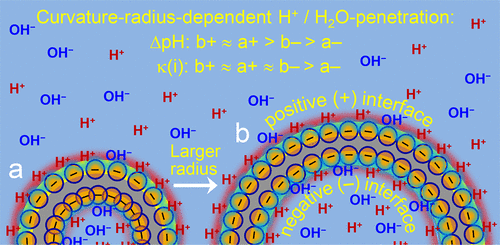Our official English website, www.x-mol.net, welcomes your feedback! (Note: you will need to create a separate account there.)
Detection of Curvature-Radius-Dependent Interfacial pH/Polarity for Amphiphilic Self-Assemblies: Positive versus Negative Curvature
Langmuir ( IF 3.9 ) Pub Date : 2017-12-21 00:00:00 , DOI: 10.1021/acs.langmuir.7b03888 Yeasmin Sarkar 1 , Rini Majumder 1 , Sanju Das 1, 2 , Ambarish Ray 2 , Partha Pratim Parui 1
Langmuir ( IF 3.9 ) Pub Date : 2017-12-21 00:00:00 , DOI: 10.1021/acs.langmuir.7b03888 Yeasmin Sarkar 1 , Rini Majumder 1 , Sanju Das 1, 2 , Ambarish Ray 2 , Partha Pratim Parui 1
Affiliation

|
It is possible that a defined curvature at the membrane interface controls its pH/polarity to exhibit specific bioactivity. By utilizing an interface-interacting spiro-rhodamine pH probe and the Schiff base polarity probe, we have shown that the pH deviation from the bulk phase to the interface (ΔpH)/interfacial dielectric constant (κ(i)) for amphiphilic self-assemblies can be regulated by the curvature geometry (positive/negative) and its radius. According to 1H NMR and fluorescence anisotropy investigations, the probes selectively interact with an anionic interfacial Stern layer. The ΔpH/κ(i) values for the Stern layer are estimated by UV–vis absorption and fluorescence studies. For the anionic sodium bis-2-ethylhexyl-sulfosuccinate (AOT) inverted micellar (IM) negative interface, the highly restricted water and proton penetration into the Stern layer owing to tight surfactant packing or a reduced water-exposed headgroup area may be responsible for the much lower ΔpH ≈ −0.45 and κ(i) ≈ 28 in comparison to ∼−2.35 and ∼44, respectively, for the anionic sodium dodecyl sulfate (SDS) micellar positive interface with a close similar Stern layer. With increasing AOT IM water-pool radius (1.7–9.5 nm) or [water]/[AOT] ratio (w0) (8.0–43.0), the ΔpH and κ(i) increase maximally up to ∼−1.22 and ∼45, respectively, due to a greater water-exposed headgroup area. However, the unchanged ΔpH ≈ −0.65 and κ(i) ≈ 53.0 within radii ∼3.5–8.0 nm for the positive interface of a mixed Triton X-100 (TX-100)/SDS (4:1) micelle justify its packing flexibility. Interestingly, the continuously increasing ΔpH trend for IM up to its largest possible water-pool radius of ∼9.5 nm may rationalize the increase in ΔpH (∼−1.4 to −1.6) with the change in the curvature radii (∼15 to 50 nm) for sodium 1,2-dimyristoyl-sn-glycero-3-phosphorylglycerol (DMPG)/1,2-dimyristoyl-sn-glycero-3-phosphocholine (DMPC) (2:1) large unilamellar vesicles (LUV) owing to its negative interface. Whereas, similar to the micellar positive interface, the unchanged ΔpH at the positive LUV interface was confirmed by fluorescence microscopic studies with giant unilamellar vesicles of identical lipids composition. The present study offers a unique and simple method of monitoring the curvature-radius-dependent interfacial pH/polarity for biologically related membranes.
中文翻译:

两性自组装的曲率半径依赖的界面pH /极性的检测:正曲率与负曲率
膜界面的确定曲率可能会控制其pH /极性,以表现出特定的生物活性。通过利用界面相互作用的螺若丹明pH探针和席夫碱极性探针,我们已经证明了两亲性自组装体从相到界面的pH偏差(ΔpH)/界面介电常数(κ(i))可以通过曲率几何形状(正/负)及其半径来调节。根据1通过1 H NMR和荧光各向异性研究,探针可选择性地与阴离子界面Stern层相互作用。斯特恩层的ΔpH/κ(i)值是通过紫外可见吸收和荧光研究估算的。对于阴离子双-2-乙基己基磺基琥珀酸钠(AOT)的反胶束(IM)负界面,由于表面活性剂的紧密堆积或减少的水暴露首基面积,水和质子向Stern层的渗透受到高度限制与具有紧密相似的斯特恩层的阴离子十二烷基硫酸钠(SDS)胶束正界面相比,ΔpH≈-0.45和κ(i)≈28分别比〜-2.35和〜44低得多。随着AOT IM水槽半径(1.7–9.5 nm)或[水] / [AOT]比的增加(w 0)(8.0–43.0),由于较大的水头组面积,ΔpH和κ(i)分别最大增加至〜-1.22和〜45。但是,对于混合的Triton X-100(TX-100)/ SDS(4:1)胶束的正界面,在半径〜3.5–8.0 nm范围内,不变的ΔpH≈-0.65和κ(i)≈53.0,证明了其包装灵活性。有趣的是,IM的不断增加的ΔpH趋势,直到其最大可能的水池半径〜9.5 nm,可以随着曲率半径的变化(〜15至50 nm)使ΔpH的增加(约-1.4至-1.6)合理化。用于1,2-二肉豆蔻酰基-sn-甘油-3-磷酸甘油酯(DMPG)/ 1,2-二肉豆蔻酰基-sn-甘油-3-磷酸胆碱(DMPC)(2:1)较大的单层囊泡(LUV),因为其为负界面。然而,类似于胶束阳性界面,通过具有相同脂质组成的单层巨大囊泡的荧光显微镜研究证实了在阳性LUV界面处的ΔpH不变。本研究提供了一种独特而简单的方法来监测生物相关膜的曲率半径依赖的界面pH /极性。
更新日期:2017-12-21
中文翻译:

两性自组装的曲率半径依赖的界面pH /极性的检测:正曲率与负曲率
膜界面的确定曲率可能会控制其pH /极性,以表现出特定的生物活性。通过利用界面相互作用的螺若丹明pH探针和席夫碱极性探针,我们已经证明了两亲性自组装体从相到界面的pH偏差(ΔpH)/界面介电常数(κ(i))可以通过曲率几何形状(正/负)及其半径来调节。根据1通过1 H NMR和荧光各向异性研究,探针可选择性地与阴离子界面Stern层相互作用。斯特恩层的ΔpH/κ(i)值是通过紫外可见吸收和荧光研究估算的。对于阴离子双-2-乙基己基磺基琥珀酸钠(AOT)的反胶束(IM)负界面,由于表面活性剂的紧密堆积或减少的水暴露首基面积,水和质子向Stern层的渗透受到高度限制与具有紧密相似的斯特恩层的阴离子十二烷基硫酸钠(SDS)胶束正界面相比,ΔpH≈-0.45和κ(i)≈28分别比〜-2.35和〜44低得多。随着AOT IM水槽半径(1.7–9.5 nm)或[水] / [AOT]比的增加(w 0)(8.0–43.0),由于较大的水头组面积,ΔpH和κ(i)分别最大增加至〜-1.22和〜45。但是,对于混合的Triton X-100(TX-100)/ SDS(4:1)胶束的正界面,在半径〜3.5–8.0 nm范围内,不变的ΔpH≈-0.65和κ(i)≈53.0,证明了其包装灵活性。有趣的是,IM的不断增加的ΔpH趋势,直到其最大可能的水池半径〜9.5 nm,可以随着曲率半径的变化(〜15至50 nm)使ΔpH的增加(约-1.4至-1.6)合理化。用于1,2-二肉豆蔻酰基-sn-甘油-3-磷酸甘油酯(DMPG)/ 1,2-二肉豆蔻酰基-sn-甘油-3-磷酸胆碱(DMPC)(2:1)较大的单层囊泡(LUV),因为其为负界面。然而,类似于胶束阳性界面,通过具有相同脂质组成的单层巨大囊泡的荧光显微镜研究证实了在阳性LUV界面处的ΔpH不变。本研究提供了一种独特而简单的方法来监测生物相关膜的曲率半径依赖的界面pH /极性。



























 京公网安备 11010802027423号
京公网安备 11010802027423号